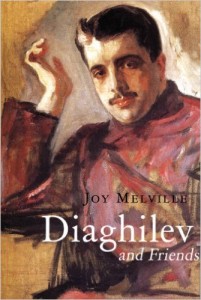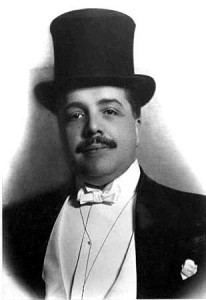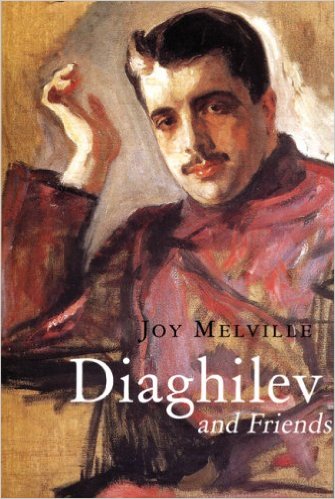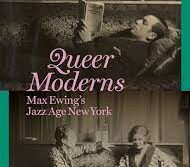 Diaghilev: and his Friends
Diaghilev: and his Friends
by Joy Melville
Haus Publishing (London). 290 pages, £20.
THIS YEAR, the centennial of the founding of Serge Diaghilev’s Ballets Russes, balletomanes have been treated to superb museum and art exhibits, film retrospectives, ballets, and panel discussions. Now comes a new biography of Diaghilev by a British journalist who has written extensively about British theatrical and cultural figures. This is a gorgeously illustrated book, with images in both black-and-white and full color, printed on high-quality paper. Included are numerous portraits of Diaghilev; photographs of friends, family, artists, nobility, and philanthropists; contemporary caricatures; drawings of Leon Bakst’s costumes (including his design for Nijinsky in the Prélude à l’après-midi d’un faune, the ballet that scandalized audiences); photos of Igor Stravinsky (who composed the music for The Firebird and Le Sacre du Printemps) and other famous dancers, both male and female.
Melville’s affection for Diaghilev—a high-maintenance man of extreme emotions, by turns kind and cruel—is apparent, but this is far from a hagiography. Diaghilev was also short-sighted: he refused to have the Ballets Russes filmed because he thought motion pictures “were merely a cheap form of entertainment.” Melville includes many facts and anecdotes about the brilliant individuals whose work was important, even in some cases peripherally, to the success of the ballet. To cite just one: “Diaghilev may not have noticed that one of Cocteau’s commissioned publicity posters for Le Spectre de la Rose showed [the ballerina Tamara]Karsavina dreaming of being kissed by Nijinsky but with a profile distinctly resembling that of Cocteau.” Melville states in her introduction that she was trying to focus on the attitudes towards homosexuality that Diaghilev, who was born in 1872, encountered in late-19th-century Russia and early-20th-century France, and she devotes a chapter to this topic, but its treatment is rather superficial. Diaghilev was brought up in the city of Perm, in the Ural Mountains, part of a musically talented, highly cultured family. As a teen, his father had urged him to visit a prostitute, and from her he contracted a venereal disease. Although he was cured physically, he never became involved in a heterosexual relationship. His first love affair was with a male cousin, but most of his lovers were dancers—Nijinsky, Leonide Massine, Serge Lifar, and the list goes on—and many of them left him to marry women. When Diaghilev turned eighteen, he received an inheritance from his mother, allowing him to buy an apartment in St. Petersburg and to study law and music, the latter in hopes of becoming a composer. In 1898, he and his friends launched a magazine called Mir Iskussiva (World of Art) which was published for six years and was Russia’s first high-quality art magazine. Its motto was “art, pure and unfettered,” and Diaghilev was acknowledged as the founding editor and the person who kept it going. Diaghilev’s experience in finding financial backers for the magazine must have stood him in great stead during all the years at the Ballets Russes when he was constantly charming the wealthy out of enough money to keep the ballet afloat, because there was no other dependable source of money. Melville says that the magazine “was a beacon, an absolute necessity” in bringing in new writing, new ideas, and new art—including the great Aubrey Beardsley. Diaghilev’s interest in ballet, Melville believes, arose when his friends were besotted with a revival of Tchaikovsky’s Sleeping Beauty. After many years defying his doctors’ orders to cut back on chocolate and alcohol, Diaghilev succumbed to diabetes in Venice, and Melville conveys in detail the pathos of his death throes, at the age of 57, in 1929. His closest friend, Misia Sert, French musician and muse to many artists, was with him, and the photograph of his flower-covered coffin, conveyed in a black gondola to his final resting place, is a poignant sight. Melville’s writing style does not always live up to the book’s packaging and is sometimes clunky; and the text is often repetitious. This book will not supplant two relatively recent, meticulously researched biographies, Richard Buckle’s Diaghilev (1979) and Lynn Garafola’s Diaghilev’s Ballets Russes (1989), the latter of which does not appear, surprisingly enough, in Melville’s bibliography. Melville has relied mostly on other biographies and autobiographies, with the occasional foray into museum archives. Still, this is an engaging work—doubtless not the last word—about a brilliant man who desperately feared getting old and was spared that fate, who would doubtless enjoy the fact that we’re still talking about him eighty years after his demise. A year after the 1905 Russian Revolution, Diaghilev organized an exhibition of Russian art in Paris, which marked the beginning of a string of great successes. This was followed by a Russian music concert series: the opera Boris Godunov at the Paris Opera and then, in 1909, the triumphant arrival of the Ballets Russes, featuring dancers from St. Petersburg’s Bolshoi and Maryinsky theaters. Melville states that Diaghilev had “transformed ballet from a moribund art form into a … vehicle for promoting avant garde ideas.” The Ballets Russes had great success in London, too, and helped seed England’s own superb ballet companies later in the century. (There were other ballet companies competing with his, including the Russian Ballet company in London in 1911, featuring the incomparable Anna Pavlova.)
A year after the 1905 Russian Revolution, Diaghilev organized an exhibition of Russian art in Paris, which marked the beginning of a string of great successes. This was followed by a Russian music concert series: the opera Boris Godunov at the Paris Opera and then, in 1909, the triumphant arrival of the Ballets Russes, featuring dancers from St. Petersburg’s Bolshoi and Maryinsky theaters. Melville states that Diaghilev had “transformed ballet from a moribund art form into a … vehicle for promoting avant garde ideas.” The Ballets Russes had great success in London, too, and helped seed England’s own superb ballet companies later in the century. (There were other ballet companies competing with his, including the Russian Ballet company in London in 1911, featuring the incomparable Anna Pavlova.)






